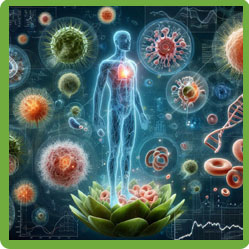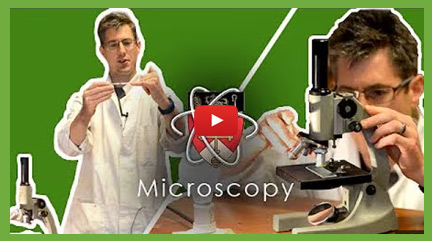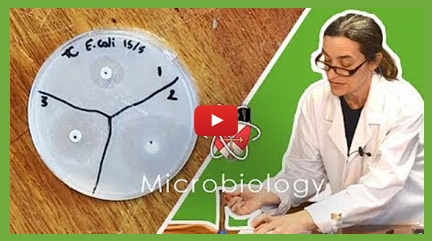
Cell Biology
Cell Biology is the study of cells – the building blocks of all living organisms. It explores the structure and function of different types of cells, how they divide, and how they carry out essential life processes. Understanding cell biology is key to topics like growth, disease, and how our bodies work.
Practicals on this page:
Using a Microscope, Bacterial Growth
Plant and Animal Cells
All living things are made of cells. Plant and animal cells are both eukaryotic, meaning they have a nucleus and other structures surrounded by membranes. These cells contain key parts like the nucleus, cytoplasm, cell membrane, and mitochondria.
Plant cells also have chloroplasts for photosynthesis, a cell wall for structure, and a vacuole for storing cell sap.
In contrast, prokaryotic cells (like bacteria) are simpler and don’t have a nucleus—their DNA floats freely in the cytoplasm. Many also have small rings of DNA called plasmids. Instead of a cell wall made of cellulose (like plants), bacteria have a cell wall made from different materials, helping them keep their shape and protect against damage.
Why Do Cells Differentiate to Become Specialised Cells?
Cell differentiation is the process by which a cell becomes specialised to carry out a particular function. In animals, most cells differentiate early in development, while plants can often differentiate throughout life.
Specialised cells include things like nerve cells (for carrying signals), muscle cells (for movement), and root hair cells (for absorbing water and minerals). Differentiation allows the body to work more efficiently by having cells designed for specific jobs.
What are Chromosomes?
Chromosomes are long strands of DNA found in the nucleus of cells. They carry genes, which are instructions that control how the body develops and functions. Humans have 46 chromosomes in total (23 pairs), with one set coming from each parent.
Chromosomes are especially important during cell division when DNA needs to be copied accurately.
What are Mitosis?
Mitosis is a type of cell division that produces two identical daughter cells, each with the same number of chromosomes as the original cell. It’s used for growth, repair, and asexual reproduction.
Before mitosis, the DNA in the cell is copied. Then, during mitosis, the chromosomes are pulled apart and new nuclei form, followed by the cell splitting.
What is Binary Fission?
Binary fission is how prokaryotic cells like bacteria reproduce. It’s a simple form of cell division where the DNA is copied, and the cell splits into two identical cells.
This process can happen very quickly, allowing bacteria to multiply rapidly in the right conditions.
What is Stem Cells?
Stem cells are unspecialised cells that can divide and develop into many different types of cell.
- In embryos, stem cells can become any type of cell.
- In adults, stem cells are more limited but can still replace certain cells, like blood or skin cells.
Stem cells have huge potential in medicine, such as treating diseases or repairing damaged tissues.
What is Diffusion?
Diffusion is the movement of particles from an area of high concentration to low concentration. It happens in gases and liquids. In cells, substances like oxygen and carbon dioxide move in and out by diffusion.
It’s a passive process, meaning it doesn’t need energy.
What is Diffusion?
Osmosis is a special type of diffusion. It’s the movement of water across a partially permeable membrane, from an area of high water concentration to low water concentration.
Osmosis is important in cells for controlling water balance and keeping cells healthy.
What is Active Transport?
Active transport is the movement of substances against a concentration gradient—from low to high concentration. Unlike diffusion, it requires energy from respiration.
It allows cells to absorb important substances like minerals from the soil (in root hair cells) or glucose in the intestines, even when there's more outside the cell.
Also see The Digestive System, Respiration, Photosynthesis, Reproduction, Transpiration.
Exam Questions & Answers

Download and print off practice our FREE worksheet with exam style questions on Cell Biology.
PRACTICAL - Using a Microscope
In this required practical, you’ll learn how to use a light microscope to observe cells, such as onion cells or cheek cells. The process involves preparing a slide with the sample, adding a stain like iodine to make cell structures more visible, and carefully placing a coverslip on top.
You’ll then use the microscope to focus on the sample at low and high magnification, draw what you see, and label key features like the nucleus, cytoplasm, and cell wall. You may also calculate the magnification and estimate the size of cells using the formula:
Magnification = Image size ÷ Real size
This practical helps you understand how microscopes work and how to observe cells in detail.
PRACTICAL - Bacterial Growth
In this required practical, you’ll investigate how bacteria grow and how different substances (like antibiotics or disinfectants) affect their growth. You’ll use agar plates as a growth medium and spread bacteria (often E. coli) onto the surface using a sterile technique.
Paper discs soaked in different chemicals are placed on the agar, and the plates are incubated at 25°C (in schools) to keep conditions safe. After a few days, you’ll measure the clear zones (called zones of inhibition) around the discs, where bacteria haven’t grown.
This practical helps you understand how to handle microorganisms safely, measure bacterial growth, and evaluate the effectiveness of antimicrobial agents.
Revision Notes

The Cornell method is like a supercharged note-taking system that helps you ace your revision!
Print out our blank revision notes pages to help you revise.
How to make effective revision notes with the Cornell method.




